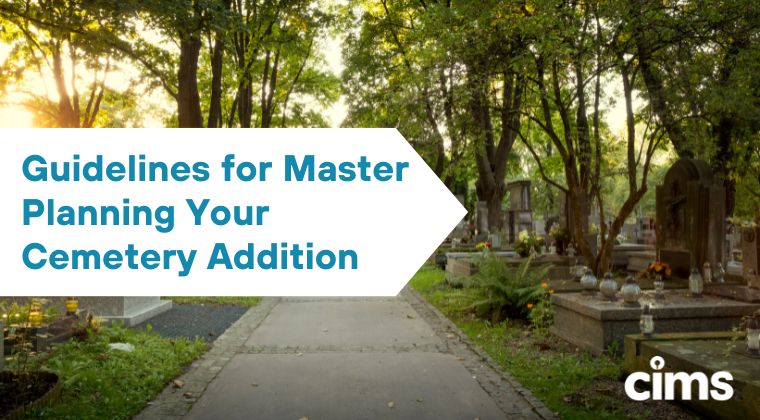Guidelines for Master Planning Your Cemetery Addition

Planning a cemetery addition is a significant undertaking that requires careful consideration, strategic planning, and meticulous execution. Whether you're expanding an existing cemetery or establishing a new section, master planning is essential to ensure the project meets current needs and anticipates future requirements. Though every cemetery and master planning process is different, approaching your planning process with efficient guidance will help make your cemetery visions come true. This guide will walk you through the typical steps in master planning your cemetery addition, helping you create a space that honors the deceased and serves the living.
1. Conduct a Needs Assessment
Before diving into the planning process, it's crucial to understand the needs and goals of your specific cemetery addition. Conduct a thorough needs assessment by considering:
- Current burial trends and future projections
- Demographic changes in the community
- Feedback from families and stakeholders
- Legal and regulatory requirements
This assessment will provide a solid foundation for your master plan, ensuring it aligns with community needs and expectations. Looking for a trusted partner to help you complete a needs assessment? Ramaker, the parent company of CIMS, is here for you!
2. Engage Stakeholders
Involving key stakeholders early in the planning process is vital. This group might include cemetery staff, board members, community leaders, and local government representatives. Engaging stakeholders ensures diverse perspectives are considered and fosters a sense of ownership and support for the project.

3. Select a Qualified Team
Assembling a team of experienced professionals is crucial for the successful execution of your cemetery addition. Consider including:
- Surveyors: To accurately map the land and identify potential issues.
- Civil Engineers: To address infrastructure needs such as roads, drainage, and utilities.
- Environmental Consultants: To ensure compliance with environmental regulations and sustainability practices.
Ramaker can provide all these services (and more) to support your cemetery addition.
4. Develop a Comprehensive Site Plan
A well-thought-out site plan is the backbone of your cemetery addition. Multiple concept plans can be considered and can include:
- Layout of Interments: Consider the types of interment options (e.g., in-ground, mausoleums, columbaria) and their placement.
- Infrastructure: Plan for roads, pathways, and utility connections.
- Landscaping: Design green spaces, gardens, and water features to create a serene environment.
- Facilities: Include necessary facilities such as restrooms, chapels, and maintenance buildings.
5. Consider Technological Integration
Modern cemetery management software, like CIMS, can greatly enhance the planning and operation of your cemetery addition. Incorporate technology to:
- Map and Manage Burial Plots: Use GIS mapping for accurate plot locations and inventory management.
- Enhance Customer Experience: Provide online plot searching and reservation capabilities.
- Improve Record-Keeping: Digitize records for easy access and secure storage.

6. Plan for Accessibility and Inclusivity
Ensure your cemetery addition is accessible to all community members by considering:
- ADA Compliance: Design paths and facilities to accommodate individuals with disabilities.
- Cultural Sensitivity: Incorporate diverse interment practices and memorialization options.
7. Implement Sustainable Practices
Sustainability is increasingly important in cemetery planning. Consider incorporating:
- Green Burial Options: Offer environmentally-friendly burial alternatives.
- Native Landscaping: Use native plants to reduce water usage and maintenance.
- Energy Efficiency: Utilize renewable energy sources and energy-efficient infrastructure.
8. Develop a Phased Implementation Plan
Given the timeline of cemetery additions, a phased implementation plan can help manage costs and resources effectively. Break the project into manageable phases, prioritizing critical areas and allowing for flexibility as needs evolve.

9. Secure Funding
Identify potential funding sources early in the planning process. Options may include:
- Grants and Loans: Explore federal, state, and local funding opportunities.
- Community Fundraising: Engage the community through fundraising campaigns and donation drives.
- Revenue Projections: Use projected revenue from plot sales to secure financing.
10. Monitor and Adjust
Once your cemetery addition is underway, continuous monitoring and adjustment are essential. Regularly review progress, gather feedback, and make necessary adjustments to ensure the project remains on track and meets the community's needs. This allows for consideration of any adjustments to time or layout of your future phases.
Master planning your cemetery can be complex, but with the right support, your cemetery will be prepared to serve the needs of your community for years to come. By utilizing these steps, partnering with qualified team like Ramaker, and leveraging modern cemetery management tools like CIMS, you can create a well-organized, beautiful, and functional space that honors the deceased and serves the living for generations to come.
For more information on how Ramaker can assist with your cemetery planning and management needs, contact us today!


